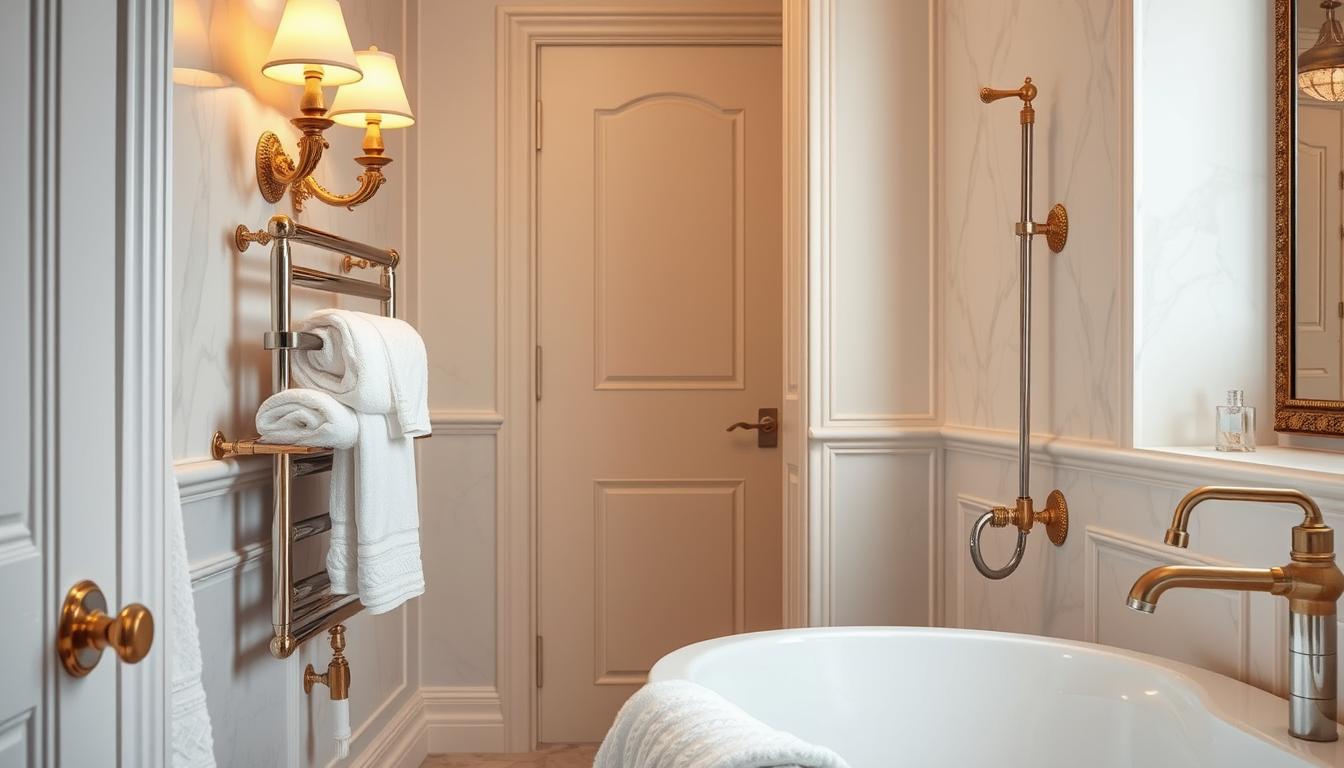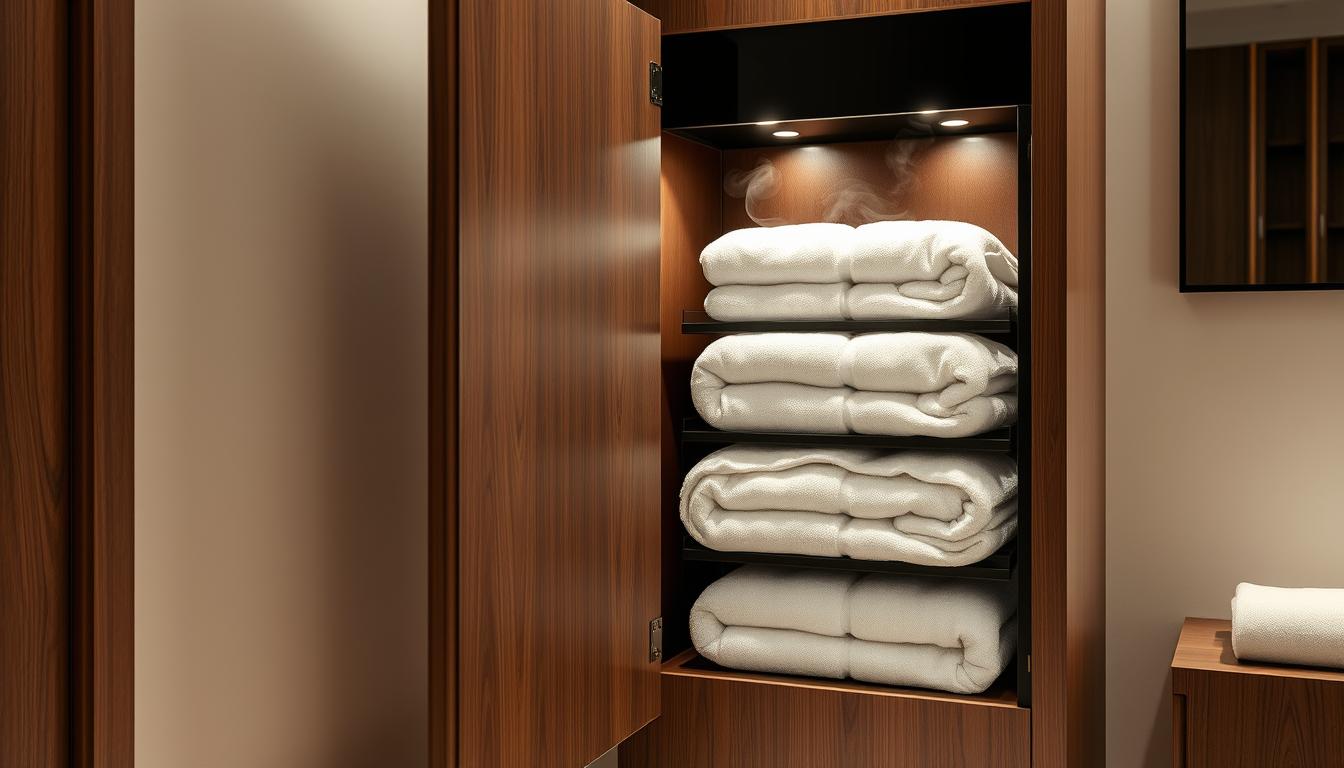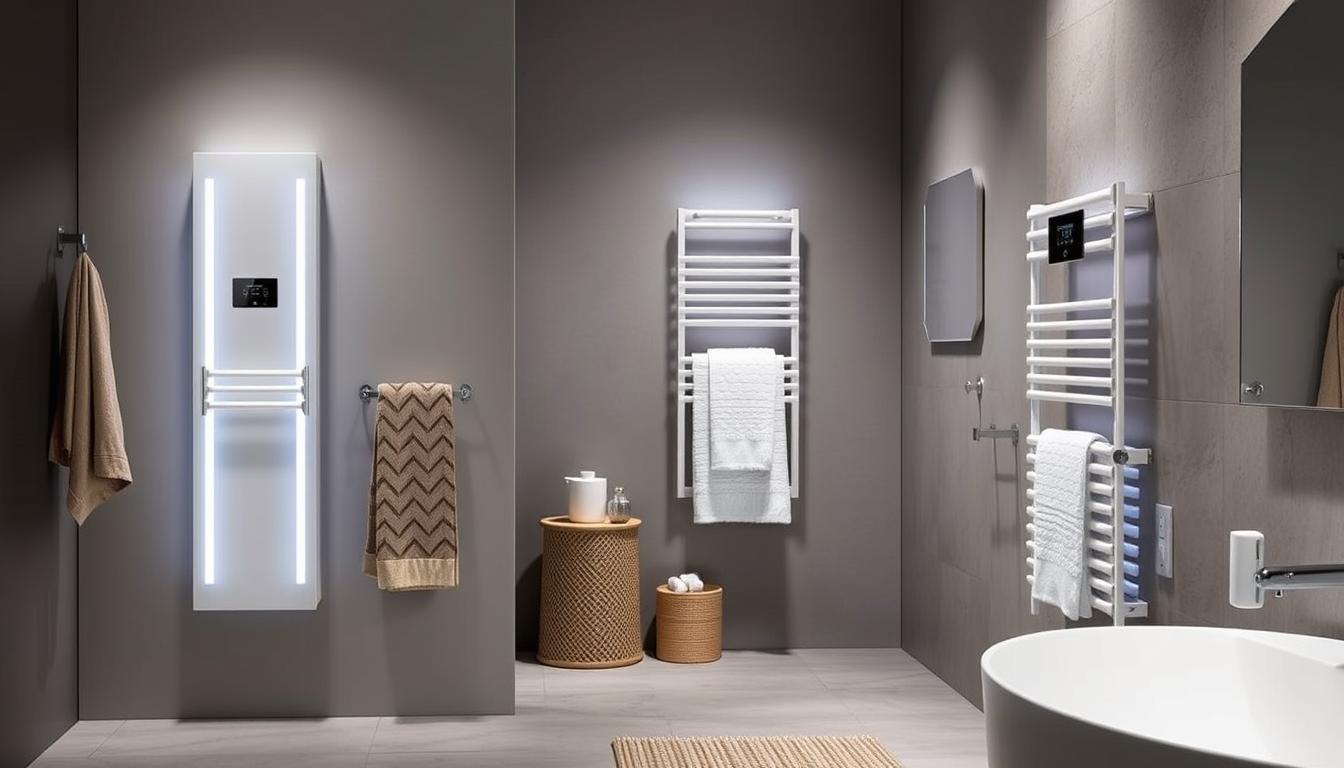Welcome to our guide on the age-old debate of bidet vs toilet! Choosing the right fixture for your home is essential for both comfort and cleanliness. In this article, we’ll explore the key differences between bidets and toilets, and help you make an informed decision.
Key Takeaways:
- Bidets and toilets serve different purposes – bidets offer a more hygienic and thorough cleaning experience, whereas toilets are primarily used for waste disposal.
- Bidets have a long history and were first introduced in France during the 17th century.
- Common misconceptions about bidets include concerns about sanitation, usability, and cost-effectiveness.
- Bidets are becoming increasingly popular in the United States due to their hygienic benefits and environmental advantages.
- Whether you choose a bidet toilet combo or a bidet attachment, a bidet can be a valuable addition to your bathroom, providing comfort and cleanliness.
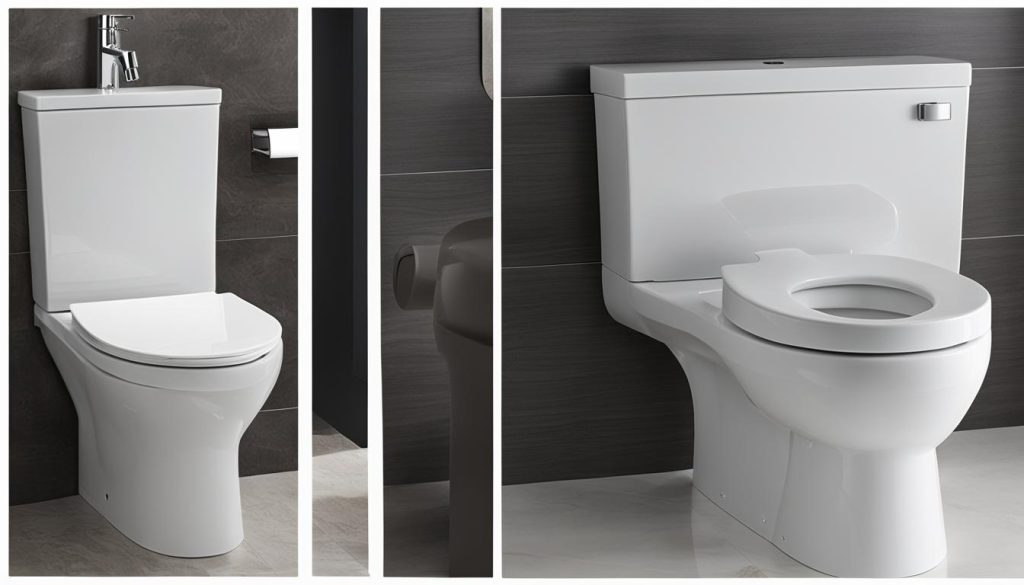
First, let’s start with the basics. A bidet is a separate bathroom fixture or an attachment that uses water to clean your private areas after using the toilet. On the other hand, a toilet is the essential fixture for human waste disposal. It’s a combination of a bowl and a flush mechanism, usually accompanied by toilet paper for cleaning.
Now, you might wonder about the origin of bidets. Surprisingly, bidets have been around for centuries and were first introduced in France during the 17th century! They were primarily used by the French aristocracy as a more hygienic way to cleanse themselves. However, bidets have gained popularity worldwide and are becoming commonplace in many American households.
It’s important to address common misconceptions about bidets. Some people may think bidets are unsanitary or difficult to use. However, bidets are designed with cleanliness in mind and can provide a more thorough and hygienic cleansing experience compared to toilet paper alone. Bidets are also more environmentally friendly, as they reduce the consumption of paper and reduce wastewater.
So, whether you’re considering a bidet toilet combo or simply adding a bidet attachment to your existing toilet, we’ve got you covered. Let’s dive deeper into the world of bidets and toilets to help you make an informed decision that meets your needs.
What is a Bidet?
A bidet is a bathroom fixture designed for personal hygiene and cleanliness. It is used after using the toilet and provides a gentle stream of water to wash the genital and anal area. Bidets come in various types to suit different preferences and bathroom setups.
Bidet Types
There are several types of bidets available in the market:
- Stand-alone bidet: This type of bidet is a separate fixture, resembling a low sink or basin. It is usually positioned next to the toilet and requires its own plumbing installation.
- Bidet toilet seat: A bidet toilet seat is a seat replacement for standard toilets. It incorporates bidet functionality by providing a spray of water for cleaning. These seats often come with various features like temperature control, adjustable water pressure, and air drying.
- Bidet attachment: A bidet attachment is a device that can be attached to an existing toilet. It connects to the water supply and delivers a stream of water for cleaning purposes. These attachments are more budget-friendly compared to stand-alone bidets or bidet toilet seats.
- Hand-held bidet sprayer: A hand-held bidet sprayer is a hose with a nozzle that can be attached to the toilet water supply. It is a convenient option for those who prefer more control over the water direction and pressure.
Each type of bidet has its own advantages and considerations. When choosing the right bidet for your bathroom, factors such as available space, budget, and personal preferences should be taken into account.
| Bidet Type | Pros | Cons |
|---|---|---|
| Stand-alone bidet | – Provides a dedicated fixture for bidet functionality – Offers a luxurious and spa-like experience – Easy to control the water temperature and pressure | – Requires additional bathroom space and plumbing installation – Higher initial cost |
| Bidet toilet seat | – Integrates bidet functionality with an existing toilet – Various features for personalized comfort – Easy installation | – Requires an electrical outlet for some models – Higher initial cost compared to bidet attachments |
| Bidet attachment | – Affordable option for adding bidet functionality – Easy installation and compatibility with most toilets – Adjustable water pressure and nozzle position | – May have limited features compared to bidet toilet seats – Connection to the toilet water supply may require additional plumbing expertise |
| Hand-held bidet sprayer | – Provides flexibility and control over water direction – Easy installation and affordability | – Requires manual handling and adjustment of water pressure – May have a learning curve for first-time users |
Note: The above table is a general comparison of bidet types and their pros and cons. The specific features and considerations may vary depending on the brand and model of the bidet.
What is a Toilet?
In this section, we will explore the fascinating world of toilets and their significance in our daily lives. From their humble beginnings to the modern fixtures we know today, toilets have come a long way in providing sanitation and convenience to households all around the world.
The Definition of a Toilet
A toilet, also known as a water closet or WC, is a plumbing fixture designed for the disposal of human waste. It consists of several key components, including:
- The bowl, which collects and holds the waste.
- The seat, providing a comfortable and hygienic surface to sit on.
- The flushing mechanism, which expels waste and water from the bowl.
A Brief History of Toilets
The history of toilets dates back thousands of years, with evidence of early toilet-like structures found in ancient civilizations. For example, the Indus Valley Civilization in present-day Pakistan had sophisticated sanitation systems as early as 2500 BCE, featuring interconnected brick-lined drains and toilets.
Fast forward to the 16th century, and Sir John Harington, an English courtier and writer, invented the “Ajax,” a precursor to the modern flush toilet. However, it wasn’t until the late 19th century that flush toilets became more widely adopted, thanks to the efforts of inventors and plumbing pioneers.
Nowadays, toilets are an indispensable part of our lives, offering convenience, privacy, and improved sanitation.
The Use of Toilet Paper
When it comes to personal hygiene in the bathroom, toilet paper is undoubtedly one of the most commonly used products. It is a soft, absorbent paper product specifically designed for cleaning oneself after using the toilet.
While toilet paper is widely used and considered a necessary item in many households, its environmental impact is a growing concern. The production of toilet paper relies heavily on wood pulp, contributing to deforestation and habitat destruction. Moreover, its disposal often leads to clogged pipes and pollution.
Here’s where bidets come into play as a more sustainable alternative to toilet paper. Bidets use water to clean the user, reducing the need for excessive toilet paper usage.
Comparison: Bidet vs Toilet Paper
| Bidets | Toilet Paper |
|---|---|
| Uses water to provide a thorough and hygienic clean. | Relies on the use of paper for cleaning, which may not be as effective. |
| Reduces the risk of hand-to-poo contact. | Does not eliminate the risk of hand contamination. |
| Environmentally friendly, as it reduces the reliance on disposable paper products. | Contributes to deforestation and pollution when not sustainably sourced or disposed of. |
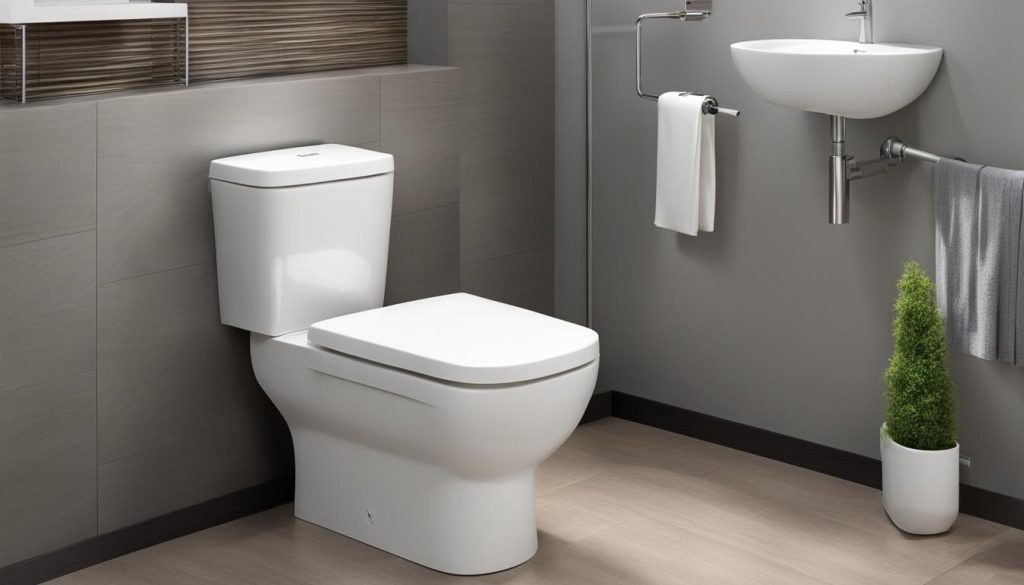
As you can see, bidets offer several advantages over traditional toilet paper in terms of hygiene and environmental impact. By considering the use of bidets, you can make a conscious choice to reduce waste and promote sustainable living.
Bidet vs Toilet: Hygiene and Comfort
When it comes to hygiene and comfort, bidets offer significant advantages over traditional toilets. Bidets provide a more thorough clean and help reduce the risk of hand-to-poo contact. The use of water ensures a gentle and effective cleanse, leaving you feeling fresh and confident.
One of the key benefits of bidets is their hygienic features. Many bidet models come with self-cleaning nozzles, which reduce the need for manual cleaning. The nozzles are designed to retract and clean themselves after each use, maintaining optimal hygiene standards. This feature not only saves time and effort but also ensures a consistently clean experience.
“Bidets offer a more thorough clean and reduce the risk of hand-to-poo contact.”
In terms of environmental impact, bidets are a sustainable choice. They require less water than traditional toilets, making them eco-friendly. On average, bidets use about 1/8th of a gallon of water per use, compared to the approximately 1.6 gallons used by toilets. This significant water conservation can make a big difference over time, reducing your household’s water consumption.
Furthermore, bidets help in tree conservation by reducing the dependency on toilet paper. The production and disposal of toilet paper contribute to deforestation and environmental pollution. By incorporating bidets into your bathroom routine, you can significantly reduce your reliance on toilet paper, contributing to a greener planet.
It’s worth considering the cost-effectiveness of bidets compared to the ongoing expense of buying toilet paper. While bidets may require a higher initial investment, they can lead to long-term savings. With bidets, you won’t need to buy toilet paper as frequently, reducing your monthly expenses. Over time, these savings can add up, making bidets a cost-effective choice.
Overall, bidets offer improved hygiene, enhanced comfort, and environmental benefits. By choosing a bidet, you can prioritize cleanliness, reduce waste, and save money in the long run.
So why settle for just a toilet when you can experience the superior hygiene and comfort of a bidet? Make the switch today!
| Bidet | Toilet | |
|---|---|---|
| Hygiene | Offers a more thorough clean and reduces the risk of hand-to-poo contact | May require additional cleaning with toilet paper or wipes |
| Comfort | Gentle and effective cleanse, leaving you feeling fresh | Relies on toilet paper, which may be less comfortable for some |
| Environmental Impact | Requires less water, conserving resources | Uses more water and contributes to deforestation with toilet paper consumption |
| Cost-Effectiveness | Higher initial investment, but long-term savings by reducing the need for toilet paper | Ongoing expense of buying toilet paper |
Using a Bidet vs Using a Toilet
Knowing how to use a bidet and a toilet correctly is essential for maintaining proper hygiene. While both fixtures serve the purpose of personal cleansing, they differ in terms of usage and functionality. In this section, we will explain the proper techniques for using a bidet and a toilet, ensuring you have a clear understanding of their respective benefits.
Using a Bidet
Using a bidet involves a simple and straightforward process. Follow these steps to effectively use a bidet:
- Before sitting on the bidet, ensure that it is clean and dry, free from any debris or excess water.
- Sit comfortably on the bidet seat, positioning yourself properly.
- Activate the water flow by either pressing a button or turning a knob.
- Adjust the water temperature and pressure according to your preference.
- Aim the water jet towards the desired area and use your hand to guide the water for a thorough cleanse.
- Gently pat yourself dry with toilet paper or use a clean towel.
- Dispose of any used toilet paper or towels properly.
- Wash your hands with soap and water.
Using a Toilet
Using a toilet is a familiar routine for most individuals. Here is a simple guide on how to use a toilet:
- Approach the toilet and raise the seat if necessary.
- Ensure that you are properly positioned over the toilet bowl, facing the front.
- Lower yourself onto the seat, making sure to maintain balance and stability.
- Relieve yourself into the toilet bowl.
- If necessary, use toilet paper to wipe yourself, starting from front to back for females to prevent the spread of bacteria.
- Dispose of used toilet paper properly in the toilet bowl.
- Flush the toilet by pressing the flush handle or button.
- Wash your hands with soap and water.
Both bidets and toilets serve a vital role in personal hygiene. By understanding the correct usage methods for each fixture, you can ensure a clean and comfortable experience.
Bidet vs Bidet Toilet Seat: Choosing the Right Option
If you are considering adding a bidet to your bathroom, you may come across two popular options: stand-alone bidets and bidet toilet seats. Both options have their own advantages and disadvantages, and it’s important to understand them before making a decision.
A stand-alone bidet offers a dedicated fixture solely for cleansing purposes. It provides a wide range of cleansing functions, including adjustable water pressure, temperature control, and various spray patterns. However, installing a stand-alone bidet may require additional plumbing work and can take up extra space in your bathroom.
On the other hand, a bidet toilet seat is a more compact and cost-effective alternative. It replaces your existing toilet seat and integrates a bidet functionality. Bidet toilet seats offer similar cleansing features as stand-alone bidets, such as adjustable water pressure and temperature control. They are also easy to install and save space in your bathroom. However, some bidet toilet seats may require access to electrical outlets for power.
When deciding between a stand-alone bidet and a bidet toilet seat, consider factors such as installation requirements, available space in your bathroom, and your budget. Think about your specific needs and preferences in terms of cleansing features and convenience. Ultimately, the choice between a stand-alone bidet and a bidet toilet seat depends on what works best for you and your bathroom.
FAQ
What are the different types of bidets available?
There are several types of bidets available, including stand-alone bidets, bidet toilet seats, bidet attachments for toilets, and hand-held bidet sprayers.
How does a bidet work?
A bidet is a bathroom fixture that sprays water to clean the genital and anal areas after using the toilet. It typically has a water source, a control panel, and a nozzle that directs the water flow.
What is the history of bidets?
Bidets originated in France in the 17th century and were primarily used by the aristocracy. They were initially designed as separate fixtures, but with advancements in technology, bidet toilet seats and attachments have become more popular.
What is a toilet?
A toilet is a sanitation fixture that is used for the disposal of bodily waste. It consists of a bowl, a seat, and a flushing mechanism to remove waste from the bowl and into the sewage system.
What is the environmental impact of using toilet paper?
The production and disposal of toilet paper have a significant environmental impact, including deforestation, water usage, and energy consumption. Bidets offer a more environmentally friendly alternative to reduce toilet paper waste.
How do bidets enhance hygiene compared to toilets?
Bidets provide a more thorough and hygienic cleansing experience compared to using toilet paper alone. They reduce the risk of hand-to-poo contact and offer additional features such as self-cleaning nozzles for improved hygiene.
How do you use a bidet?
To use a bidet, simply sit on the bidet or toilet seat bidet, activate the water flow, adjust the temperature and intensity as desired, and cleanse the genital and anal areas using the water spray. Then, pat dry with a towel or use a dryer if available.
How do you use a toilet?
Using a toilet involves sitting on the toilet seat, eliminating waste into the toilet bowl, and flushing to remove the waste from the bowl.
What are the pros and cons of stand-alone bidets?
Stand-alone bidets offer a dedicated cleansing device and come in various styles and designs. However, they require additional space and plumbing installation, which may be inconvenient and costly.
What are the pros and cons of bidet toilet seats?
Bidet toilet seats are convenient as they can be easily installed on an existing toilet. They offer adjustable water pressure and temperature, but they may be more expensive compared to bidet attachments.
